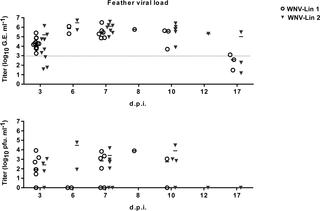PLOS Neglected Tropical Diseases ( IF 3.4 ) Pub Date : 2018-04-10 , DOI: 10.1371/journal.pntd.0006394 Nereida Jiménez de Oya , María-Cruz Camacho , Ana-Belén Blázquez , José-Francisco Lima-Barbero , Juan-Carlos Saiz , Ursula Höfle , Estela Escribano-Romero

|
West Nile virus (WNV), a zoonotic pathogen naturally transmitted by mosquitoes whose natural hosts are birds, has spread worldwide during the last few decades. Resident birds play an important role in flavivirus epidemiology, since they can serve as reservoirs and facilitate overwintering of the virus. Herein, we report the first experimental infection of magpie (Pica pica) with two strains of West Nile virus, lineages 1 (NY-99) and 2 (SRB Novi-Sad/12), which are currently circulating in Europe. Magpies were highly susceptible to WNV infection, with similar low survival rates (30% and 42.8%) for both lineages. All infected magpies developed viremia detectable at 3 days post-infection with titers above those necessary for successful transmission of WNV to a mosquito. Neutralizing antibodies were detected at all time points analyzed (from 7 to 17 days post-infection). WNV genome was detected in the brains and hearts of all magpies that succumbed to the infection, and, in some of the surviving birds. WNV-RNA was amplified from swabs (oral and cloacal) at 3, 6 and 7 days post-infection and feather pulps, from 3 to 17 days post-infection, of infected animals. Even more, infectious virus was recovered from swabs up to 7 days post-infection and from feather pulps up to 10 days post infection. Sham-infected control animals were negative for viremia, viral RNA, and antibodies. These results suggest that the magpie, which is one of the most abundant corvid species in Europe, could represent a source of WNV transmission for birds and humans. Our observations shed light on the pathogenesis, transmission, and ecology of WNV and can benefit the implementation of surveillance and control programs.
中文翻译:

喜ica(Pica pica)对世系1和2西尼罗河病毒实验性感染的敏感性高。
西尼罗河病毒(WNV)是一种通过人的自然宿主为蚊子的蚊子自然传播的人畜共患病原体,在过去几十年中已在世界范围内传播。居民鸟类在黄病毒流行病学中起着重要作用,因为它们可以充当水库并促进病毒的越冬。在此,我们报告了喜experimental(Pica pica)和两株西尼罗河病毒株,谱系1(NY-99)和谱系2(SRB Novi-Sad / 12),目前在欧洲流通。喜pies对WNV感染高度敏感,两种谱系的存活率相近(分别为30%和42.8%)。所有被感染的喜pies在感染后3天均出现可检测到的病毒血症,滴度高于成功将WNV传播至蚊子所必需的滴度。在分析的所有时间点(感染后7至17天)均检测到中和抗体。在所有死于感染的喜pies的大脑和心脏中,以及在一些存活的鸟类中,都检测到了WNV基因组。在感染后3、6和7天从拭子(口腔和泄殖腔)中扩增WNV-RNA,在感染后3至17天从羽毛浆中扩增WNV-RNA。更,从感染后长达7天的拭子和羽毛浆中直至感染后10天,回收了感染性病毒。假感染的对照动物的病毒血症,病毒RNA和抗体均呈阴性。这些结果表明,Europe是欧洲最丰富的弯曲物种之一,可能代表鸟类和人类传播西尼罗病毒的来源。我们的观察结果揭示了WNV的发病机理,传播和生态状况,并且可以有利于实施监视和控制程序。


















































 京公网安备 11010802027423号
京公网安备 11010802027423号